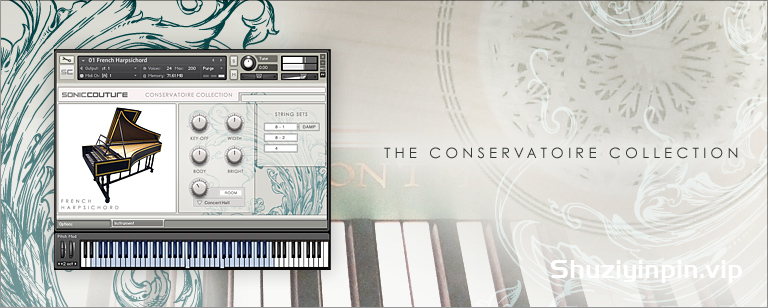
Team: KRock | Date: July 25 2012 | Size: 8.76 GB
探索大师的声音世界
伟大作曲家的乐器如今已成为博物馆藏品,已有数百年历史,无法演奏。
但近年来,古乐器专家开始以复制乐器的形式重现我们过去的音乐。
通过寻找真实的材料并运用16、17和18世纪的传统技术,人们可以制作出对最精美的历史乐器进行极其精确的复制。
这些精美的新乐器将我们过去的音乐声景带入生活,向我们展示了现代乐器前辈的多样性。现在,我们能够更忠实地了解我们的音乐遗产,而新的音色也为当今的作曲家提供了新的灵感。
01. 法国大键琴
这架乐器是保罗·塔斯金于1762年制作的大键琴的复制品,后来由让·戈尔曼斯于1780年扩大。原件是18世纪被复制最多的大键琴之一,迈克尔·约翰逊的复制品被高度评价为忠实的复制品。
– 具有用户可选音阶的完全调音控制
– 两个可切换的 8′ 弦组,带阻尼
– 具有电平控制的离键样本
– 循环样本以获得自然响应
02. 佛兰芒大键琴
迈克尔·约翰逊复制了约翰内斯·拉克斯于 1637 年制作的一把大键琴。样本库使用的复制品是迈克尔·约翰逊于 2000 年制作的。一般来说,17 世纪的大键琴比 18 世纪的大键琴更小,而且明显更短。
– 具有用户可选音阶的完全调音控制
– 2 x 8′ 带阻尼和 4′ 弦组
– 具有电平控制的离键样本
– 循环样本以获得自然响应
03. 西尔伯琴
马丁·海科克于 2005 年根据各种十七世纪的意大利原版制作的单弦 14 弦乐器。这个文艺复兴晚期的发明是当时最终极的伴奏乐器 – 通过在琴颈上增加延伸部分,可以演奏低音的粗弦与传统的鲁特琴并列放置,这意味着演奏者可以演奏低音线并给出节奏。
– 音格手位置控制:让您可以控制在指板上演奏音符的位置
– 完全调音控制,用户可选择音阶
– 单独的音格和音梁释放控制
04. 英国西尔伯琴
虽然没有幸存的原始乐器,但有几幅关于 17 世纪中叶英国西尔伯琴的描述、插图和绘画。该乐器由 Klaus Jacobson 于 2005 年制作。英国西尔伯琴与它发展而来的 12 弦小鲁特琴有很多共同之处,但它吸收了更大的意大利西尔伯琴的元素,比如低音琴身。
– 音阶手位置控制:让您控制在指板上弹奏音符的位置
– 完全调音控制,用户可选择音阶
– 单独控制音阶和音柱的释放
05. 巴洛克吉他
法式五弦乐器:Martin Haycock 制作的十七世纪多件原件的复制品。该乐器的弦排列很不寻常:五弦对应于现代吉他的顶部琴弦,但除了顶部 E 弦外,其他都是双弦。在 17 世纪早期,吉他主要用作伴奏乐器,为舞蹈演奏或为歌手伴奏。
– 音阶手位置控制:让您控制在指板上弹奏音符的位置
– 完全调音控制,用户可选择音阶
– 卷积室处理器
06. 诗篇
诗篇是最古老的乐器之一,在《圣经》和许多古希腊文献中都有提及。
诗篇是一种全音阶乐器,用于演奏和弦或旋律。演奏时,双手各持一根羽毛笔拨动琴弦。由于演奏者不会停止音符的移动,较长的衰减时间赋予这种乐器一种空灵的音质。-
完全调音控制,用户可选择音阶
– 循环叠加,响应自然
07. 巴洛克定音鼓 定音鼓
是纳克鼓(主要用于户外演奏)的继承者。定音鼓最初与小号一起用于仪式场合,到 18 世纪,它在管弦乐队中找到了新的用武之地。与现代鼓相比,这种鼓更小巧,使用小牛皮鼓面,无需踏板即可调音。
– 3 种演奏技巧:击打、滚动和颤音
– 可选皮革和木制鼓槌
– 循环分层,响应自然
08. 文艺复兴侧鼓
这是一种中大型鼓,鼓壳较长,两端的鼓皮用木环固定。鼓皮可以收紧,下部鼓皮上有一个由两根肠弦制成的小鼓。
– 击打、颤音和滚动演奏技巧
– 循环分层,响应自然
09. 纳克鼓
纳克鼓是一种小型鼓,起源于阿拉伯,具有金属或木制圆顶状鼓身和动物皮鼓面。纳克鼓成对演奏,在十三世纪十字军东征时期传入欧洲。采样的乐器是 Montagu 收藏中这对鼓的复制品。
– 左右手映射
– 循环层以实现自然响应
10. 手摇风琴
这种乐器是海牙市立博物馆 16 世纪原件的复制品,是文艺复兴晚期的典型代表。
文艺复兴中期典型的手摇风琴有三根持续音弦(由肠线制成)、两根旋律弦和一根用于发出节奏的更高的持续音弦,称为小号。它有一个嗡嗡作响的琴码(chien,字面意思是“狗”),当演奏者增加对风琴轮的压力时,它会发出刺耳的声音。传统上,演奏者会随着音乐的节奏转动风琴轮,用手腕在转动风琴轮的同时产生节奏。最后两根弦(鸡油菌弦)是旋律弦。
手摇风琴是一种集旋律、和声和节奏于一体的乐器。即使演奏者没有有意识地进行节奏演奏,也没有使用旋律弦鸡油菌弦或嗡嗡作响的小号持续音,风琴轮的每次转动也会产生自然的节奏波动。
– 3 根低音弦:G1、C2、G2 布局,
– 2 根 Chanterelle 弦在 G3 处齐奏。-
小号弦:更高的 C 或“调高”到 D。-
“嗡嗡键”用于有节奏的演奏
– 按键噪音控制
EXPLORE THE SOUNDWORLDS OF THE MASTERS
The instruments of the great composers are museum pieces now; hundreds of years old and not in playable condition.
But in recent times period instrument specialists have begun recreating our musical past in the form of reproduction instruments.
By sourcing authentic materials and using traditional techniques from the 16th, 17th and 18th centuries, incredibly accurate copies of the finest historical instruments can be produced.
These beautiful new instruments bring the soundscape of our musical past to life, showing us how incredibly diverse our modern instruments’ predecessors were. We are now able to enter into our musical heritage more faithfully, and the new palette of sounds available offers fresh inspiration for composers today.
01. French Harpsichord
This instrument is a copy of a harpsichord originally made by Paul Taskin in 1762 and later enlarged by Jean Goermanns in 1780.The original instrument is one of the most copied 18th century harpsichords, Michael Johnson’s copy is highly regarded as a faithful reproduction.
– Full tuning control with user selectable scales
– Two switchable 8′ string sets, with damping
– Key-off samples with level control
– Round robin samples for natural response
02. Flemish Harpsichord
A Michael Johnson copy of a harpsichord made by Johannes Ruckers, made in 1637.The copy used for the sample library was made in 2000 by Michael Johnson. Generally speaking, 17th century harpsichords are smaller, and, significantly, shorter than those of the 18th century.
– Full tuning control with user selectable scales
– 2 x 8′ with damping and 4′ string sets
– Key-off samples with level control
– Round robin samples for natural response
03. Theorbo
A single-strung, 14 course instrument made by Martin Haycock in 2005, after various seventeenth century Italian originals. This late Renaissance invention was the ultimate accompanying instrument of the time – by adding an extension to the neck, thick strings giving low notes were placed alongside the conventional lute meaning a player could play a bass- line and give the rhythm.
– Fret Hand postion control: gives you control over where on the fretboard the note will be played
– Full tuning control with user selectable scales
– Seperate release control for the frets and diapazon
04. English Theorbo
Although there are no surviving original instruments, there are several descriptions, illustrations and paintings of English theorbos dating from the mid- 17th C. This instrumentwas made by Klaus Jacobson in 2005.The English theorbo has much in common with the small 12-course lute, from which it developed, but it takes elements of the larger, Italian theorbo, such as the deep body.
– Fret Hand postion control: gives you control over where on the fretboard the note will be played
– Full tuning control with user selectable scales
– Seperate release control for the frets and diapazon
05. Baroque Guitar
A French style, five- course instrument: a copy of various seventeenth century originals, made by Martin Haycock. The stringing of the instrument is unusual: the five courses correspond with the top strings of modern guitars, but they are double-strung apart from the top E. During the early 17th C, the guitar was primarily used as an accompanying instrument, playing for dances or accompanying singers.
– Fret Hand postion control: gives you control over where on the fretboard the note will be played
– Full tuning control with user selectable scales
– Convolution Room processor
06. Psaltery
The Psaltery is one of the oldest of all musical instruments, mentioned in the Bible and in numerous ancient Greek texts.
A Psaltery is a diatonic instrument, used to play chords or melodies. It is played by plucking the strings with quills, one in each hand. As the notes are not stopped by the player, the long decay time give this instrument an ethereal quality.
– Full tuning control with user selectable scales
– Round robin layers for natural response
07. Baroque Timpani
The successor to the nakers – primarily an outdoor instrument – was the timpani. Used at first for ceremonial occasions with trumpets, by the 18th century the timpani found a new home in the orchestra. The drums are smaller compared to their modern counterparts, they use calf-skin drum heads, and are tuned to different notes without the aid of pedals.
– 3 Articulations : Hit, Roll and Trill
– Selectable leather and wooden beaters
– Round robin layers for natural response
08. Renaissance Side-drum
This is a medium large drum with a long shell and skins at either end held in place by wooden rings. The skins can be tightened and on the lower skin there is a snare mechanism made from two gut strings.
– Stick, trill and roll articulations
– Round robin layers for natural response
09. Nakers
A naker is a small drum, of Arabic origin, with a metal or wood dome-shaped body and animal skin drum head. Played in pairs, nakers made their way to Europe at the time of the Crusades in the thirteenth century. The instruments sampled were copies of the pair in the Montagu collection.
– Left and right hand mapping
– Round robin layers for natural response
10. Hurdy Gurdy
This instrument is a copy of a sixteenth century original in the Gemeentemuseum, The Hague, and is typical of those of the late Renaissance.
A typical hurdy gurdy of the mid-Renaissance era featured three drones strings ( made of gut), two melody strings and a further higher drone string used for rhythm, known as the trompette. This features a buzzing bridge (chien – literally “dog”) which creates a harsh sound when the player increases pressure on the wheel. Traditionally, the player would play turn the wheel to the tempo of the music, using his wrist to effect a rhythm whilst turning the wheel. The last two strings (chanterelle(s)), are the melody strings.
The nature of the hurdy gurdy is one of an all-in-one melody, harmony and rhythm instrument. Even without the player consciously playing rhythmically, and playing without the melody strings chanterelles or the buzzing trompette drone, there is a natural rhythmic fluctuations with each cycle of the wheel.
– 3 Drone strings : G1, C2, G2 layout,
– 2 Chanterelle strings tuned in unison at G3.
– Trompette string : a higher C or “Tuned Up” to D.
– ‘Buzz key’ for rhythmic playing
– Key noise control

![[5件套日本乐器音源 筝 尺八 篠笛 三味线 神乐铃] Japanese instrument OtowabiKagurasuzu OtowabiShinobue Ra-shamisen Ra-sakuhachi Ra-KOTO [KONTAKT](312.17MB+)](https://www.shuziyinpin.vip/wp-content/uploads/2025/04/1745752287564-1024x588.png)
![[创意电影宝库]Audio Imperia Photosynthesis Series Vol.1 Sphere [KONTAKT](1.1GB)](https://www.shuziyinpin.vip/wp-content/uploads/2025/04/Photosynthesis-Series-1.jpg)
![[大提琴音源]PulseSetter Sounds Cello Ibrida [KONTAKT](4.21GB)](https://www.shuziyinpin.vip/wp-content/uploads/2025/04/artworks-S5Goc7zwWllmd7XY-0Ubfiw-t500x500.jpg)
![[施坦威D-274钢琴音源]Vienna Symphonic Library Synchron Concert D-274 (Resampling) v1.0.0 [KONTAKT](143GB)](https://www.shuziyinpin.vip/wp-content/uploads/2025/04/19042526_vienna-symphonic-library-synchron-concert-d-274-resampling.png)
![[经典 FM 合成器的采样音源]Amazound DX-TX Vol.1 [KONTAKT](259MB)](https://www.shuziyinpin.vip/wp-content/uploads/2025/04/dx-tx-vol-1-kontakt-samples-512x512-1.jpg)
![[4套电影钢琴独奏系列音源]Fracture Sounds Soloists Collection [KONTAKT](40GB+)](https://www.shuziyinpin.vip/wp-content/uploads/2025/04/5b826b19-c248-4001-a664-196e919d5088-1-1024x722.png)

评论0